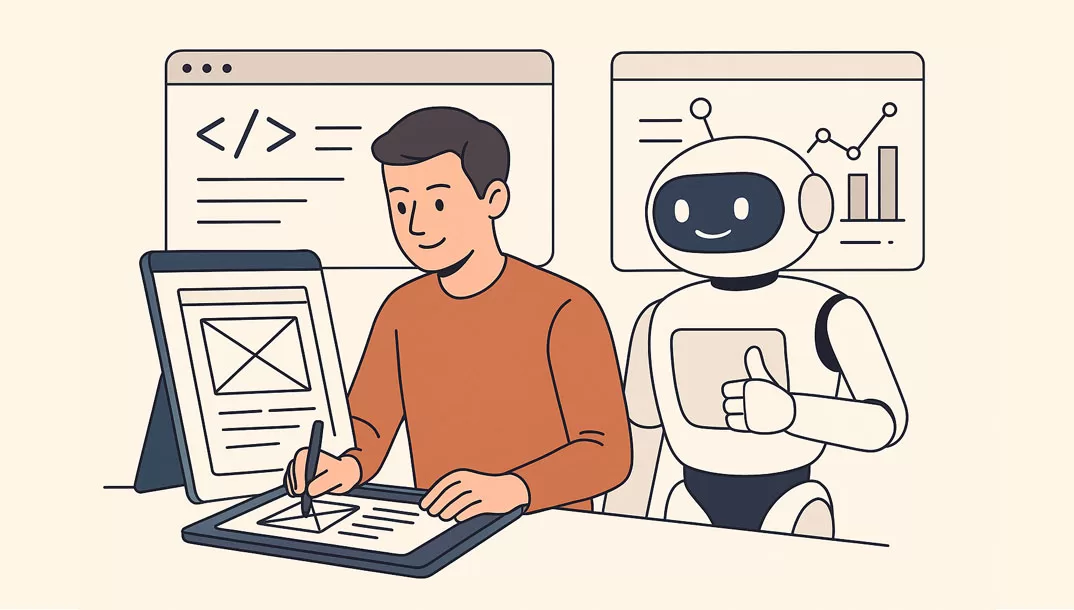What AI Can’t Do: Why UI/UX Designers Will Always Matter


-
Written by
vsampath
-
Category
AI Agent, UI Design, User Experience
-
Date
May 23, 2025
AI is transforming the design landscape—but not in the way you might think.
If you’re a UI or UX designer, you’ve probably asked yourself:
“Can AI do my job better than me?” This is a common concern in the ongoing conversation of AI vs UI/UX Designers.
The truth is, while AI is becoming a powerful design tool, it can’t replace what makes you special—creativity, empathy, and problem-solving. The future of UI/UX design isn’t about competing with AI—it’s about understanding what AI can and can’t do, and how you can stay ahead.
To stay ahead, brands and designers must rethink traditional experience design elements like UI, UX, CX, and BX through the lens of agentic interaction.
How Competitive Is AI in Design?
Let’s start with what AI can do—and it’s impressive.
AI tools like Uizard, Figma’s smart features, Maze, Hotjar, and Amplitude are already being used to:
Generate wireframes in seconds
Align and resize UI components automatically
Analyze user behavior across large data sets
Provide insights to improve user flows and experience
In short?
AI is fast, consistent, and incredibly efficient—especially with repetitive tasks and data analysis.
What AI Does Well
Let’s break down a few areas where AI is clearly a strong performer in the UI/UX world:
1. Automating Repetitive Tasks
UI Designers: Think layout alignment, button resizing, and auto-updating design systems.
UX Designers: Tools like Maze help you run usability tests faster, making validation more accessible.
2. Analyzing Large Datasets
UI: AI can scan A/B tests and suggest what works.
UX: It uncovers patterns in user journeys, improving persona mapping and experience flows.
3. Working at Lightning Speed
AI doesn’t sleep. It processes, tests, and suggests improvements in real-time—perfect for tight deadlines or rapid prototyping.
Where AI Falls Short
Despite the hype, AI isn’t ready to replace human designers. Here’s where it falls flat in the AI vs UI/UX Designers equation:
1. Creativity & Innovation
AI works based on what already exists—it can remix ideas, but it can’t invent new ones.
Designers create brand stories, explore emotion through color and layout, and take risks that spark innovation.
2. Context & Empathy
AI sees patterns in user behavior, but it doesn’t understand people.
UX designers dig deeper: they ask questions, observe behavior, and design solutions rooted in real human needs.
3. Complex Problem-Solving
Inclusive design, ethical decisions, and accessible experiences require emotional intelligence and critical thinking—two things AI just can’t replicate (yet).
How to Future-Proof Your Design Career
To stay relevant in this AI-enhanced world, double down on your human strengths and evolve with the tech. Here’s how:
1. Master Design Systems
UI: Build scalable, flexible systems in tools like Figma.
UX: Ensure systems enable smooth, accessible, and inclusive flows.
2. Get Stronger at Research
AI can give you the data—but you are the one who turns it into insights.
Invest in skills like usability testing, user interviews, and behavioral psychology.
3. Lean Into Creativity
Bring bold, new ideas to the table. Whether you’re experimenting with interaction design or storytelling, your creativity is your competitive edge.
4. Solve for the Hard Stuff
Tackle design challenges that AI can’t handle—like accessibility, inclusive experiences, and designs for neurodiversity users. These are high-value areas where human designers shine.
Final Thoughts
AI is reshaping UI/UX design, but it’s not a replacement—it’s a collaborator.
If you’re a designer, your job is evolving, not disappearing. Those who thrive will be the ones who embrace AI as a tool while continuing to push the boundaries of human-centered design.
The future of design isn’t man versus machine—it’s man with machine.
Use AI to handle the heavy lifting, so you can focus on what you do best: dreaming, designing, and delivering meaningful experiences.